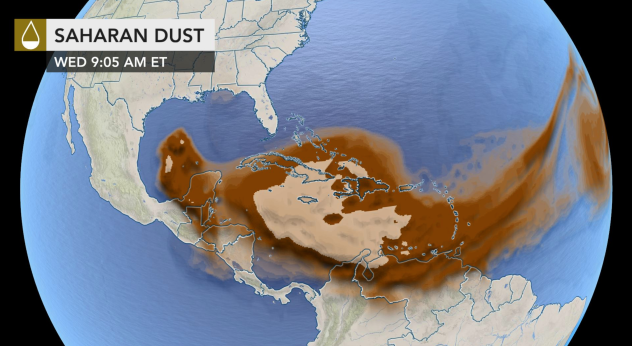Fact check: Picture of a massive dust cloud is over Phoenix, not Puerto Rico
Editor's note: The Facebook post mentioned below has since been deleted.
The claim: A photo depicts largest ever dust cloud over Puerto Rico which caused damages
Last week, a huge cloud of Sahara dust traveled over the Caribbean and the Southern U.S. A second wave of dust is predicted to hit other parts of the U.S. later this week.
While no infrastructural concerns were expected, a June 23 Facebook post claims that the dusty weather phenomenon has wrecked devastation on the Caribbean island of Puerto Rico.
"Well, well, well... You thought God was done? Here comes a 'Godzila' Sahara dust cloud. Largest ever recorded in history, compared to one of 50 years ago in the US.
This cloud just passed Puerto Rico and caused damages. No one could leave their home, not only because of Covid-19 but also because you couldn't see or breath in this. It's expected to hit the US soon and do the same. Worrisome due to the respiratory concerns we already have in the US because of Covid-19, let's not mention the heat wave following behind that can cause fires."

The text accompanies an image of a colossal, tsunami-like cloud of dust bearing down on a populated area. The image has been viewed over 285,000 times since posted.
The Facebook user who created the post has not yet returned USA TODAY’s request for comment and clarification.
A dust cloud but not the right one
The image of an enormous dust cloud overtaking land is quite frightening but also misleading. The picture captured is by photographer Jerry Ferguson during a helicopter ride in 2018. Ferguson was covering a seasonal monsoon in Phoenix, not Puerto Rico.
“These haboobs are fairly common during Arizona’s monsoon season (June 15-September 30),” Ferguson said in an interview with PetaPixel.
Haboobs are very strong dust and sandstorms that move through hot, dry regions, according to NOAA. They are not related to Saharan dust clouds.
What is a Saharan dust cloud?
Despite the novelty of the name, Saharan dust clouds are quite a common weather occurrence. Every year between late spring to early fall, dusty air accumulates over the Sahara Desert across northern Africa. This accumulation of dusty air, known as the Saharan Air Layer, moves into the tropical Atlantic Ocean every three to five days, according to NOAA's Hurricane Research Division. The Saharan Air Layer can occupy a roughly 2-mile thick layer in the atmosphere and carry nearly 182 million tons of dust, or enough to fill 689,290 semitrucks.
This year's dust plume is being considered the most extreme out of all dust-related weather events.

"This event … was the largest event that we have ever seen over 50 years that we have been in Barbados,” Joe Prospero, an atmospheric scientist and professor emeritus at the University of Miami, said in an interview with the Washington Post. “It’s pretty clear this was a phenomenal event. We know that the aerosol concentrations were the highest we’ve ever measured by a substantial amount.”
Possible dangers from Saharan dust
While Saharan dust contains minerals, such as phosphorous, which enrich the Amazon rainforest, the most pressing concerns for humans are reduced air quality and pollution. Some studies across the globe have found dust exposure a possible risk factor for cardiopulmonary disease; experts in the U.S. worry about dust's impacts on other health problems.
“This can be an allergen that is uncomfortable with asthma or reactive airways,” Dr. Sandro Galea, dean of the Boston University School of Public Health, said in an interview with The New York Times.
Dr. Len Horovitz, a pulmonary specialist at Lenox Hill Hospital in New York City, also warned, in an interview with the Times, that “particulate matter of this dust cloud contains more silica, and is a hazard to those with underlying lung conditions. But even normal healthy people are subject to irritant effects.”
There have been no known reports out of Puerto Rico as to damages from Saharan dust, health-related or otherwise.
Our ruling: False
We rate the claim that a picture of a dust cloud seen over Puerto Rico that caused damages as FALSE because it is not supported by our research. The Facebook image does not depict a Saharan dust cloud over Puerto Rico, rather a 2018 haboob, a different type of dust storm, over Phoenix. And while there are concerns of health risks due to Saharan dust, there are no known reports of health damages or otherwise out of Puerto Rico.
Our fact-check sources:
PetaPixel, "This Massive Dust Storm Was Shot from a Fleeing News Helicopter."
NOAA, "Haboobs: Phenomena with the unusual name is no joke."
NOAA's Atlantic Oceanographic and Meteorological Laboratory, "The Saharan Air Layer."
NASA, "NASA Satellite Reveals How Much Saharan Dust Feeds Amazon’s Plants."
New York Times, "Massive Saharan Dust Cloud to Move Across Southeast U.S. This Week."
Thank you for supporting our journalism. You can subscribe to our print edition, ad-free app or electronic newspaper replica here.
Our fact check work is supported in part by a grant from Facebook.
This article originally appeared on USA TODAY: Fact check: Image of dust cloud is over Phoenix not Puerto Rico

